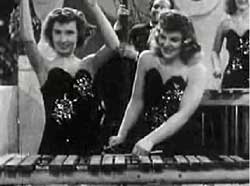 The Panoram had a 27-inch screen with back-projection, inside an elegant wooden cabinet, looking not unlike televisions of the 1950s. They played popular music of the era, not on 78 or 45 records like previous jukeboxes, but on two to three minute film strips. The Panoram had a 27-inch screen with back-projection, inside an elegant wooden cabinet, looking not unlike televisions of the 1950s. They played popular music of the era, not on 78 or 45 records like previous jukeboxes, but on two to three minute film strips.
The first Panoram Jukeboxes were manufactured in 1939 by the Mills Novelty Company in Chicago, a company that had been around since 1905 & also made vending machines, gamblers' slot machines, the very first Coca Cola vending machines, & all sorts of coin-operated apparatus, including automatic musical instruments such as a violin that played itself for a nickle.
It really wasn't until 1941 that Panorams were widely encountered, after Jimmy Roosevelt entered this business arena. He was the son of Franklyn Delano Roosevelt. From business savy & no doubt due to his family connections he made a fortune in the insurance game. He invested his money by producing Panoram jukeboxes, & he funded & produced the "soundies" that played on Panorams.
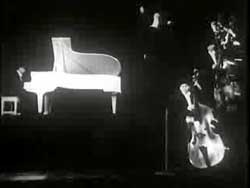 These little films were printed backward so they'd be viewed forward on the rear projection screen. That's why a great many of them as played now on video appear to have exclusively left-handed performers. These little films were printed backward so they'd be viewed forward on the rear projection screen. That's why a great many of them as played now on video appear to have exclusively left-handed performers.
But some of the soundies were simultaneously printed forward & shown in cinema houses, or grouped together in sets of two or three soundies for a longer movie house extra, in days when a trip to the cinema got you two films, a newsreel, a cartoon, & any number of extras; Saturday matinees could last the entire afternoon.
The wee films in the panorams cost a dime each to play. Restaurants, hotels, & taverns rented the films for ten dollars a week, & they could generate about fifty dollars a week. The performers were paid very little, as the films helped sell their records, plus they served as screen tests which performers might otherwise have to pay a thousand dollars to have filmed to submit to Hollywood producers.
Perhaps not always but in the majority of cases the performers recorded the song in advance, then played it again without sound as near as possible in a manner identical to the recording session. This sometimes results in performances that appear out of sync, but it is no mere lipsyncing, it's just that the visual performance & the sound recording were separate but combined events.
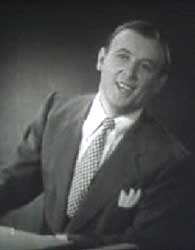 With a few soundies in 1940 & thousands of soundies by 1946, often these represent the only moving picture records of performers from this era, besides some of the greats. With a few soundies in 1940 & thousands of soundies by 1946, often these represent the only moving picture records of performers from this era, besides some of the greats.
By 1948 the Panorams were no longer popular. Service on the Panorams dwindled & no new soundies were being made. The machines were more & more relegated to the junk yard or attics & back rooms of curio shops, preserved mostly thanks to collectors of kinetoscopes & silent film projectors & other machines of bygone days.
But I remember seeing a Beatles soundie when I was a little kid, which I played in a little cafe for my dime. The screen was substantially smaller than a Panoram, & an overall disappointment to me who loved the Beatles more than anything on earth except my dog, but could barely see the performance & wanted my dime back.
This was the Scopitone Jukebox which never fully caught on in America, though they became a transient fad in France. Scopitone jukeboxes broke down too easily & had poor support in days when organized crime controlled jukebox distribution throughout much of America. Just try telling a gangster you're not going to pay the rental fees until they fix the machine. And the scopitone films were not very well attuned to modern musical tastes.
So while soundies played in jukeboxes were a thing of the 1940s, similar mini-films picked up again in the 1960s as two-minute scopitones.
Some soundies were made for other purposes such as band promotionals, or as little films to promote major films. There were lots of theatrically released pre-jukebox soundies, as one- & two-reeler musicals came to be called by the same name.
When more narrowly defined, one-reelers weren't soundies & true soundies were made for visual jukeboxes. Yet retroactively any short music-oriented film from the birth of sound to the 1950s have come to be called soundies. In places like Harlem, a "soundie" meant any music-film with an all black cast, & I don't think anyone knows whether this street usage predated Panoram soundies or was retroactively applied beginning in the 'fifties.
Some few of the ten-minute one-reelers & slightly longer short musicals told comic stories or occasional dramas, but the real purpose was always the tunes, not the acting or stories, to qualify even in the broader sense as soundies. The directors of one-reel music-films & three minute soundies overlapped & often the only difference was the length.
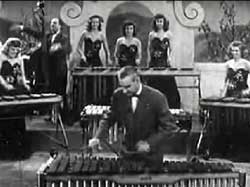 An interesting & fun novelty act, Reg Kehoe & His Marimba Queens star in one of the simply marvelous soundie A Study in Brown (1944). An interesting & fun novelty act, Reg Kehoe & His Marimba Queens star in one of the simply marvelous soundie A Study in Brown (1944).
Though the group can seem corny the musicianship is really very good & this is one of the most fun soundie ever made.
The group really go to town on the marimbas, Reg the only guy with marimba putting himself center forward, surrounding himself like a Turkish sultan with babes pounding away on additional marimbas.
They were around from the late 1930s to the mid 1950s, but were just about entirely forgotten until a private collector of soundies posted this soundie on the world wide web, kindling renewed interest. Alas, this is the only visual recording of their act, but there are a handful of song recordings.
A jaunty happy arms-tossing double-bass cello player is the only other guy in the odd little band. This is Frank DeNunzio, Sr., & partway through the performance, he carries his bass from the back of the set to the front & begins slapping the hell out of it like a cello-shaped bongo, looking like he's having a wonderful fit & might swallow his tongue. That dude was still around still slapping the bass when he was ninety.
Among the marimba queens is Fern Marie Kehoe nee Henry (at Reg's far right) & Ruth Hauser, but beats me which is her among all those gals. They're playing a ragtime number & it's awfully cute, though ragtime on marimbas sure sounds like it ought to accompany a cartoon cat chasing a cartoon mouse through a cartoon graveyard of skeletons playing their own ribs.
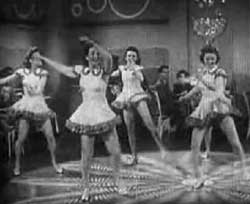 Jiveroo (1943) opens on a nightclub scene with excellent dancing girls going full tilt with short-skirt leg-kicking action. These are the June Taylor Girls. Years later the June Taylor Dancers would be weekly performers on television's Jackie Gleason Show. Jiveroo (1943) opens on a nightclub scene with excellent dancing girls going full tilt with short-skirt leg-kicking action. These are the June Taylor Girls. Years later the June Taylor Dancers would be weekly performers on television's Jackie Gleason Show.
The dance act "Harry Day & Della" join in with a fine combination of jazz dance & boogie woogie with even some high-stepping cake-walk moves -- old fashioned steps jazzed up for modern big band sound.
Harry Day's toreodor jacket & pants are funny enough to be great. He also does some rhumba-like heal-moves so ultra-fast it's like the film was speeded up, & he was either desparate to steal the show or joker at heart, can't tell which.
As a rule soundies are about the music & dancers are optional as well as nameless. But this soundie is so about the dancers that it's the orchestra that has been left uncredited.
Jiveroo was not only a jukebox soundie but was also distributed through the market for 8 mm & 16 mm films to be shown on home projectors. It was combined with two other soundies (Billy Burt's weird Jazz Etude & The Three Chefs' Breakfast in Rhythm), distributed as Jazz & Jitters (1945).
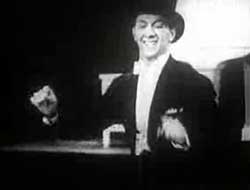 Another dance soundie, Jazz Etude (1941), featured dancer Billy Burt, included in the Castle Films release of three soundies Jazz & Jitters (1943) together with The June Taylor Dancers in Jiveroo & The Three Chefs in Breakfast in Rhythm (1943). Another dance soundie, Jazz Etude (1941), featured dancer Billy Burt, included in the Castle Films release of three soundies Jazz & Jitters (1943) together with The June Taylor Dancers in Jiveroo & The Three Chefs in Breakfast in Rhythm (1943).
We see the band first in a surrealist array, pianist & three double-bass performers floating in darkness, pounding out rather experimental jazz.
The white piano seems phosphorescent. The pianist has a totally blank face, like a performing robot, which is appropriate to the overall mood, & incredible to me that the musicians are uncredited.
Billy seems to be very tiny as he walks over the top of the piano, comes to the center of the film, & begins some tap work.
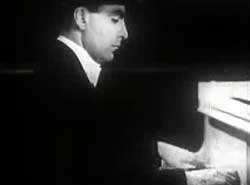 He's wearing a black tux against a black background, so all that shows are his hands, face, shoes, & part of the white shirt under his black jacket, so he's kind of a dancing ghost. He's wearing a black tux against a black background, so all that shows are his hands, face, shoes, & part of the white shirt under his black jacket, so he's kind of a dancing ghost.
Made very early in the soundie era, someone forgot to tell the anonymous director that soundies weren't supposed to be quite this cool, aimed at the masses, not the artsy fartsy intelligentsia.
There's a brilliant avant garde quality to the visual arrangement as well as the performers' expression of almost nightmarish music & dance.
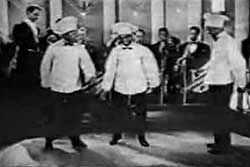 Slowly we see a bit more of the environment of stairs & floors for Billy's wildly tapping danse macabre. The mad pace becomes faster until it seems impossible Billly's not screaming "help me!" but he's still smiling as the screen goes dark. Slowly we see a bit more of the environment of stairs & floors for Billy's wildly tapping danse macabre. The mad pace becomes faster until it seems impossible Billly's not screaming "help me!" but he's still smiling as the screen goes dark.
Breakfast in Rhythm completes the cycle of three "dancies" collected as Jazz & Jitters. The Three Chefs literally dress like cooks in a fancy restaurant, which aren't exactly cool outfits for a dance routine. They mix a rap routine with their tapdancing.
In the background Barry Paige & His Orchestra, who according to the title card must be playing a new number called "Be Careful" though it sounds like nothing but a general orchestral beat for the rapping & tapping.
It's amusing & idly entertaining, but it's nothing special. If I were in a restaurant & three actual cooks came out & did this, I'd be impressed, but if I'd paid to see a show, & these guys were the best it offered, I'd be upset.
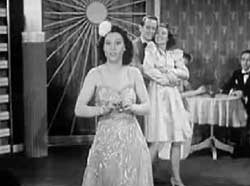 In I Can't Give You Anything But Love, Baby (1941) Caroline Marsh gives a so-so little performance with a bigband back-up from Ray Bloch & His Orchestra, including a muted horn solo. In I Can't Give You Anything But Love, Baby (1941) Caroline Marsh gives a so-so little performance with a bigband back-up from Ray Bloch & His Orchestra, including a muted horn solo.
Like a lot of soundies, the shoot is arranged to look like a nightclub floor show, with a couple elegant dance couples on the floor. Those sunray panels decorating the backdrop will be seen again & again in soundies from 1941.
Carolyn had a moderate success in the late 1930s but was a mite too generic to & so ended up with the reliable but ordinary Ray Bloch orchestra. Bloch made a great many soundies & Carolyn sings on four of them.
The dancers get a giant bite-size of the soundie's short length & really show off. They're fun to watch.
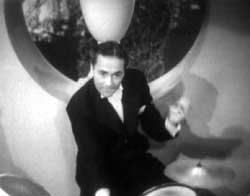 What a great little soundie is Twelfth Street Rag (1041). Charles "Buddy" Rogers on trumpet blows a super ragtime the likes of which Red Nichols would envy.
What a great little soundie is Twelfth Street Rag (1041). Charles "Buddy" Rogers on trumpet blows a super ragtime the likes of which Red Nichols would envy.
Buddy's with an orchestra on a set decked out like a rooftop cafe with climbing vines & flowers, the backdrop faking a view of the city.
He ditches his horn & runs to the back of the orchestra to take over the slap base for a while. Very exciting, but not nice to the regular bass player who probably would've liked to have done the solo himself. But the point here is to show how amazingly talented Buddy is, & he momentarily takes over the drum kit for a smiling solo of considerable merit.
Hopping off the drum stool he rushes to the front of the band to grab & play in turn the sax, the clarinet, & the muted slide trumbone. That rat bastard is good on everything. He even makes an accordion sound hip.
copyright © by Paghat the Ratgirl
|
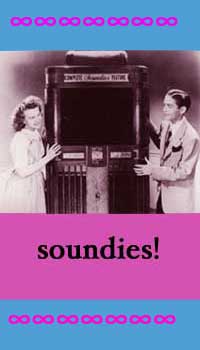

 These little films were printed backward so they'd be viewed forward on the rear projection screen. That's why a great many of them as played now on video appear to have exclusively left-handed performers.
These little films were printed backward so they'd be viewed forward on the rear projection screen. That's why a great many of them as played now on video appear to have exclusively left-handed performers.



 He's wearing a black tux against a black background, so all that shows are his hands, face, shoes, & part of the white shirt under his black jacket, so he's kind of a dancing ghost.
He's wearing a black tux against a black background, so all that shows are his hands, face, shoes, & part of the white shirt under his black jacket, so he's kind of a dancing ghost. Slowly we see a bit more of the environment of stairs & floors for Billy's wildly tapping danse macabre. The mad pace becomes faster until it seems impossible Billly's not screaming "help me!" but he's still smiling as the screen goes dark.
Slowly we see a bit more of the environment of stairs & floors for Billy's wildly tapping danse macabre. The mad pace becomes faster until it seems impossible Billly's not screaming "help me!" but he's still smiling as the screen goes dark.
